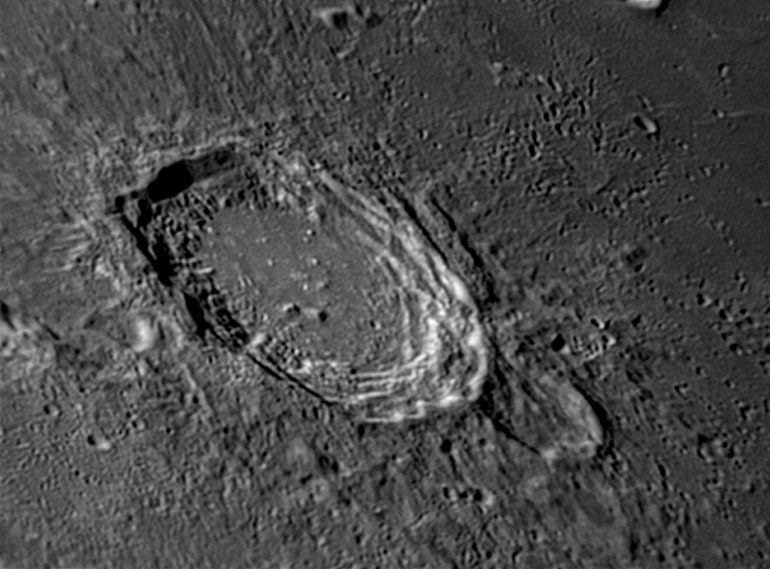|
|
| (5 intermediate revisions by the same user not shown) |
| Line 1: |
Line 1: |
| | __NOTOC__ | | __NOTOC__ |
| | =Eating a Smaller Fry= | | =Eating a Smaller Fry= |
| | + | <!-- Start of content --> |
| | <div class="post" id="post-1379"> | | <div class="post" id="post-1379"> |
| | | | |
| Line 6: |
Line 7: |
| | <p>[[File:Aristoteles-LPOD.jpg|Aristoteles-LPOD.jpg]]<br /> | | <p>[[File:Aristoteles-LPOD.jpg|Aristoteles-LPOD.jpg]]<br /> |
| | <em>image by [mailto:pcasquinha@netvisao.pt Paulo Casquinha], Portugal</em></p> | | <em>image by [mailto:pcasquinha@netvisao.pt Paulo Casquinha], Portugal</em></p> |
| − | <p>There are two major trends in the history of lunar cratering: in the first billion years there were many more impacts than more recently, and their average size was larger. Thus all the large impact basins formed before about 3.8 billion years ago, and the youngest craters, as seen on the maria, are generally smaller than older ones exposed in the highlands. There are exceptions, of course: [http://the-moon.wikispaces.com/Copernicus Copernicus] is big - 93 km in diameter and young - about 900 million year old. And on Earth the [http://www.lpl.arizona.edu/SIC/impact_cratering/Chicxulub/Discovering_crater.html Chicxulub] impact crater is huge (~180 km in diameter), but younger than [http://the-moon.wikispaces.com/Tycho Tycho] (65 m.y.). As a result of these two trends, it is common to see (for example, [http://the-moon.wikispaces.com/Clavius Clavius]) small craters on older large ones. But [http://the-moon.wikispaces.com/Aristoteles Aristoteles] is one of the less frequent examples of the reverse. Aristoteles (87 km diameter) formed on the western end of 30 km wide [http://the-moon.wikispaces.com/Mitchell Mitchell]. The actual age of Mitchell is impossible to tell because it is so badly disfigured by Aristoteles’ ejecta. It is possible that Mitchell got a little revenge - about where its western rim should be is a backwards terrace on the inner wall of Aristoteles. This little block of wall casts a shadow toward the east, whereas most of the other terraces drop down toward the center of the crater. </p> | + | <p>There are two major trends in the history of lunar cratering: in the first billion years there were many more impacts than more recently, and their average size was larger. Thus all the large impact basins formed before about 3.8 billion years ago, and the youngest craters, as seen on the maria, are generally smaller than older ones exposed in the highlands. There are exceptions, of course: [https://the-moon.us/wiki/Copernicus Copernicus] is big - 93 km in diameter and young - about 900 million year old. And on Earth the [http://www.lpl.arizona.edu/SIC/impact_cratering/Chicxulub/Discovering_crater.html Chicxulub] impact crater is huge (~180 km in diameter), but younger than [https://the-moon.us/wiki/Tycho Tycho] (65 m.y.). As a result of these two trends, it is common to see (for example, [https://the-moon.us/wiki/Clavius Clavius]) small craters on older large ones. But [https://the-moon.us/wiki/Aristoteles Aristoteles] is one of the less frequent examples of the reverse. Aristoteles (87 km diameter) formed on the western end of 30 km wide [https://the-moon.us/wiki/Mitchell Mitchell]. The actual age of Mitchell is impossible to tell because it is so badly disfigured by Aristoteles’ ejecta. It is possible that Mitchell got a little revenge - about where its western rim should be is a backwards terrace on the inner wall of Aristoteles. This little block of wall casts a shadow toward the east, whereas most of the other terraces drop down toward the center of the crater. </p> |
| | <p>[mailto:tychocrater@yahoo.com Chuck Wood]</p> | | <p>[mailto:tychocrater@yahoo.com Chuck Wood]</p> |
| | <p><strong>Technical Details:</strong><br /> | | <p><strong>Technical Details:</strong><br /> |
| Line 12: |
Line 13: |
| | <p><strong>Related Links:</strong><br /> | | <p><strong>Related Links:</strong><br /> |
| | Rükl plate 5</p> | | Rükl plate 5</p> |
| − | <p align="center"> | + | <p><b>Yesterday's LPOD:</b> [[September 10, 2007|US-1 and Other Signposts]] </p> |
| − | <em>Now you can support LPOD when you buy ANY book from Amazon thru [[LPOD]]</em></p> | + | <p><b>Tomorrow's LPOD:</b> [[September 12, 2007|Rimae Fantasticus]] </p> |
| | + | <!-- Removed reference to store page 2 --> |
| | </div> | | </div> |
| − | ---- | + | <!-- End of content --> |
| − | ===COMMENTS?===
| + | {{wiki/ArticleFooter}} |
| − | Click on this icon [[image:PostIcon.jpg]] at the upper right to post a comment.
| |




